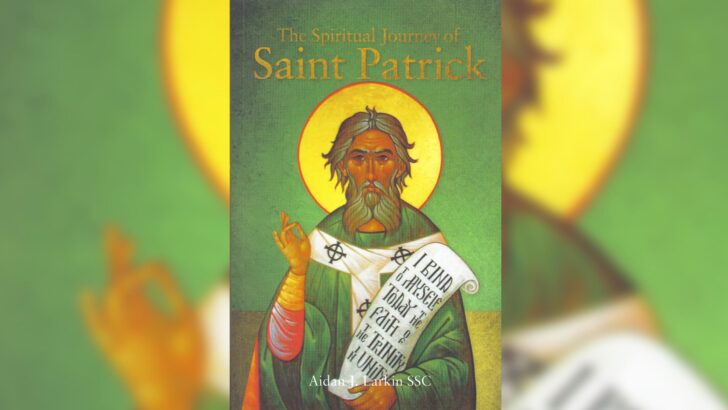The Spiritual Journey of St Patrick by Aidan J. Larkin SSC, with a foreword by Archbishop Eamon Martin (Messenger Publication, €14.95/£12.95)
Tomorrow all the world that is Irish will mark St Patrick’s Day, mostly in ebullient hoolies it has to be said, rather than calm and settled consideration. Well, that is the way of the world, and if the actual man himself is concealed behind all the faux episcopal fancy dress and a vanguard of leprechauns with red beards and green hats, such we have to admit is the nature of modern Irish culture.
Some of the recent books about Patrick have been very strange too; one of the strangest of all to my mind being the biography by Dr Roy Flechner of UCD, St Patrick Retold (Princeton University Press, £20.00), which suggests that the saint was a sort of financial fugitive in Ireland, who was avoiding his taxes back in Roman Britain while indulging in a little slave trading, importing slaves for Irish chieftains from the same territory into Ireland.
Speculative
These notions seem a step too speculative to many, so it is a relief to turn to this latest book about Patrick to find a very different treatment of the saint, his life and the two documents from his own hand that have survived the confusions of history. That we have such records, The Confession and the Letter to Coroticus is nearly unique; their voice is so very different to what we find in later Irish manuscripts of a religious nature.
For a long time, however, they were used by scholars only for biographical and historical purposes. But in this book they are closely examined by the late Fr Aidan J. Larkin, a Columban father, of very varied experience (including election as an SDLP member of the Northern Ireland Assembly).
In what he writes he was inspired by another Columban at Dalgan Park, Fr Daniel Conneely, and by the edition of Conneely’s essays on Patrick edited after his death by Fr Paddy Bastable (a man and scholar still recalled with fondness by his lay friends). Fr Larkin completed this new treatment of the material before his death in 2019.
Documents
He has translated the documents anew providing them with introductory chapters and notes. The central part of what is said is to demonstrate, in following Fr Conneely, that these writings show what has not been widely noticed enough that Patrick’s memory and mind was suffused with a knowledge of a select number of Latin Fathers – he lived in fact at the end of the history period of the Latin Fathers.
Taking up again Fr Conneely’s original discovery or insights rather, Larkin mentions Athanasius, Augustine, Cyprian, Hilary, Ignatius, Jerome and Justin. But also it is to be noted that in the documents he lays a great emphasis on his status as a bishop, with the implication that his status, indeed his whole standing in Ireland, had been challenged. These matters are still difficult to unravel. But Patrick’s depth of acquaintance with the Latin Fathers, though, doubtless a product of the time he is thought to have spent at St Lerin’s Monastery off the south coast of Gaul, suggests a thorough training.
But early Irish Christianity quickly began to take on characteristics of the native society, in the creation of abbot-led monasteries on a tribal basis, which soon established themselves as the central feature of Christianity in Ireland, displacing the position of bishop.
The leading role of the families of local rulers is a prominent feature too. So in a sense the Church Patrick brought into the country was quickly nationalised, and seemed open to the influence of Greek culture as well as Latin.
The role of Patrick in history is not a trivial matter, even if the man himself now seems to me on his way to becoming for all too many people a figure of fun. Fr Larkin’s book may play a small role in putting that to right.
***
Ireland’s pre-Patrician Christians – who were they?
The reference to Palladius by papal records of a mission in 431 of Palladius to “those Irish believing in Christ” has always presented a puzzle and still does. These Christians may not have been Irish in fact, but traders with bases ashore, rather like the people who shipped Patrick out of Ireland (though they were pagans). The parallel is with those trading posts along the coasts and rivers of 19th Century West Africa, or out in the Malaya’s or the islands of Indonesia.
They exported animals alive, as there was no way of keeping slaughtered beasts fresh, or Irish wolf hounds, which were much in demand in Europe. The posts would not have been on the dangerous west coast of Ireland, but along the south coast from Dingle (an important port in the Middle Ages), through Waterford to Wexford, a run of coast line focused on Ardmore in Waterford.
The boats would have run to the south of England, perhaps to Glastonbury, and to Brittany where Patrick said he had kinsfolk. Those trade items being carried out of the country would have left little trace ashore, except perhaps a misty recollection of a religious heritage, which St Patrick’s greater fame extinguished or absorbed.


 Peter Costello
Peter Costello 'The Spiritual Journey of St Patrick' by Aidan J. Larkin SSC
'The Spiritual Journey of St Patrick' by Aidan J. Larkin SSC